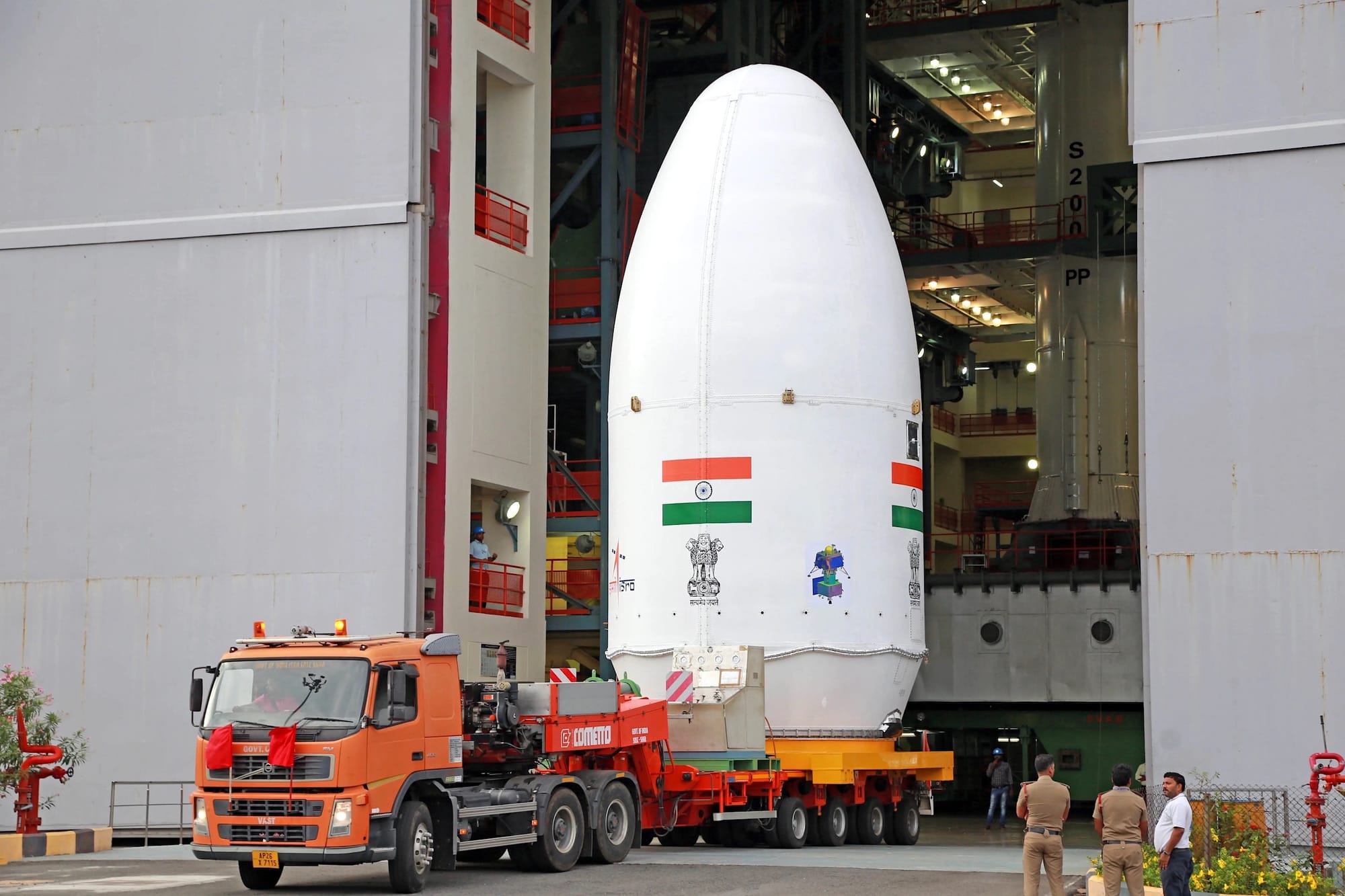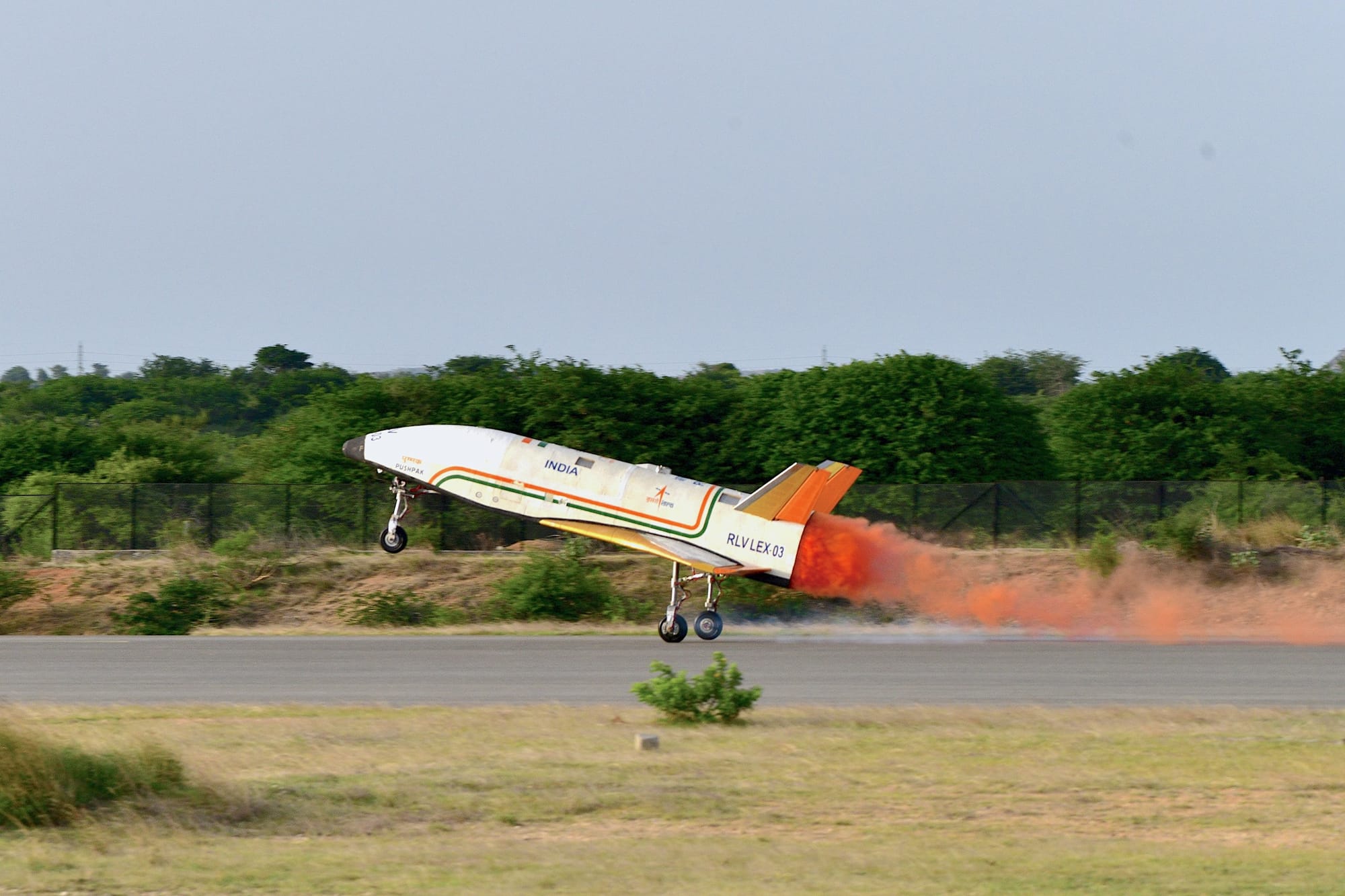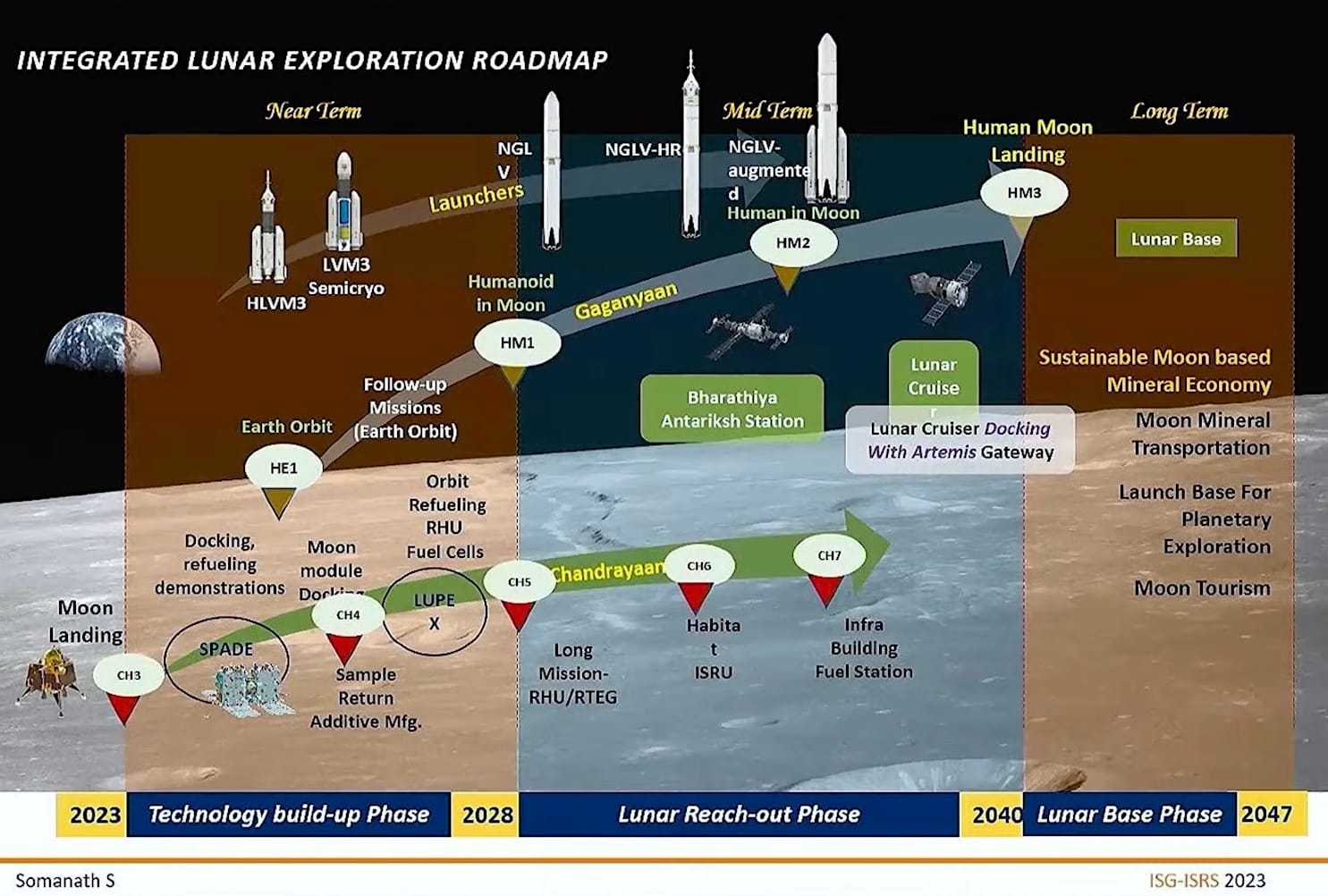Indian Space Progress #18: A flat budget, increasing mass to orbit, continuing Chandrayaan, and pushes for private space
I hope you enjoy this bird’s-eye view of all major developments in India’s space trajectory over the last two months! 🚀
India’s space budget for FY2024

Despite the many highs of 2023 for Indian space, the FY2024 budget of $1.56 billion for the country’s Department of Space (DOS)—of which ISRO gets the major chunk—has essentially stayed flat. The 18% increase over the previous financial year may seem significant but that’s only because the revised total expenditure of $1.32 billion during FY2023 was lower than the amount allocated for it. Notably, DOS underutilized its space technology budget in FY2023 by about $150 million, a trait the country’s Ministry of Science & Technology as a whole suffers from. As Mukunth has pointed out previously, it’s the latest example illustrating that increasing ISRO’s budget alone isn’t a solution in itself for continuing advances in space.
There’s some more incentive for space startups though. Earlier this year, during the interim national budget announcement, India’s Finance Minister Nirmala Sitharaman had announced the availability of $12 billion dollars in interest-free loans across 50 years for Indian tech startups—including space ones—to tap into. Now, Sitharaman has announced a pool of about $120 million in venture capital funding for space startups to apply for, a move many Indian space industry experts are cautiously optimistic about. In any case, just like the government opening up approval-less foreign direct investments (FDI) for the country’s private space sector, this can be seen as a welcome option now available to India’s nascent startup ecosystem.
What India’s flat FY2024 space budget gives a clearer picture of is ISRO’s continued limited approach to deep space exploration and human spaceflight despite the rhetoric. As I explained in my article about ISRO taking on increasingly complex lunar and crewed exploration missions, India’s approach to even attempt its ambitious milestone missions would be different than the US or China, and that it would progress gradually at best. Even without budget underutilization, ISRO simply lacks the kind of resources that NASA and CNSA enjoy, with governmental Indian space funding being only a tenth to twentieth of China and the US, and private funding for deep space exploration being nearly zero.
Increasing mass to orbit, and a spaceplane
While ISRO works with the Indian industry to ramp up the production rate of India’s most powerful rocket, the Launch Vehicle Mark III (LVM3), from the current two a year to four and then six, the agency is also testing an engine upgrade to LVM3’s core stage. ISRO will replace its current two Vikas engines with an indigenously built 2000 KiloNewton semi-cryogenic kerolox engine called SCE-200. This will increase the rocket’s GTO capacity from ~4,000 kilograms to at least ~5,000. ISRO is also testing engine restart capability for LVM3’s upper stage cryogenic engine to enable more complex mission profiles.
At the India Space Congress 2024 in New Delhi late June, the Director of ISRO’s Liquid Propulsion Space Center, V. Narayanan, said that the target to launch an SCE-200 on an LVM3 is 2027, a point in time later than originally expected but still early enough to be leveraged by the upcoming complex Chandrayaan and initial Gaganyaan missions.

On June 23, ISRO successfully landed their uncrewed, autonomous spaceplane prototype called the Reusable Launch Vehicle Technology Demonstrator (RLV-TD) on a runway at Chitradurga, India for the third time. Notably, the craft reused the winged body and many flight systems from the second landing test with minimal modifications, and steered through more stringent drop conditions. As seen in the video, ISRO used an engine smoke marker this time to better trace the descent trajectory for future improvements. As Chethan Kumar reported, ISRO next aims to fly a 60% larger RLV (named Pushpak) as the third stage of a modified GSLV Mk II rocket so as to test the spaceplane’s atmospheric reentry from orbit.
ISRO envisions the RLV not as a satellite deployer as much as a means to autonomously operate onboard payloads and experiments for a month or more in space and then bring them back to Earth for valuable follow-on studies. Media outlets have frequently compared the RLV to NASA’s retired Space Shuttle but ISRO is neither designing Pushpak to carry humans nor is it intended to be a heavy-lift launch vehicle. As a highly autonomous platform, Pushpak is more akin to the flying Boeing X-37B and Sierra Space’s upcoming Dream Chaser.
Many thanks to the Takshashila Institution, KaleidEO, PierSight, Gurbir Singh and Arun Raghavan for sponsoring this month’s Indian Space Progress report. If you too love my work of trying to capture true trajectories of Indian space, join them!
Chandrayaan updates

- Since official information from ISRO regarding India’s lunar and crewed exploration plans remains vague and scattered in bits and pieces, which also make it difficult for media reports to capture missions in context, I have compiled and laid down everything we know about ISRO’s plans for undertaking increasingly complex robotic Chandrayaan missions, where human spaceflight comes in, and what realistic timelines look like:
- By combining optical, radar, neutron, and other data from NASA’s Lunar Reconnaissance Orbiter (LRO), complemented by the ISRO Chandrayaan 2 orbiter’s dual-frequency radar observations, a new study led by several Indian scientists estimates that the Moon’s poles host five to eight times more water ice 1-3 meters underground than near the surface. They also find that the extent of such water ice appears to be about twice as large on the lunar north than south. The study also suggests that the Moon’s past volcanism is the primary source of this subsurface water ice but not all researchers agree. Either way, the study has implications for the many upcoming lunar missions dedicated to studying the nature, abundance, and accessibility of lunar water, which include CNSA’s upcoming Chang’e 7 mission, the JAXA-ISRO LUPEX rover, and NASA’s Lunar Trailblazer orbiter.
- At the Secure World Foundation’s Summit for Space Sustainability, a Korean researcher presented on July 11 how NASA, ISRO, and KARI have been voluntarily sharing information about the exact trajectories of their active (near-)polar lunar orbiters. The agencies use the NASA MADCAP software to predict and get notified about uncomfortably close approaches between the orbiters after which a decision can be taken for one of the craft to perform a diversion maneuver. Recall that in October 2021, ISRO commanded its Chandrayaan 2 orbiter to change its orbit slightly for avoiding a close approach of about 3 kilometers to NASA’s Lunar Reconnaissance Orbiter (LRO). In the May 2023 summary of India’s space activities, ISRO mentioned that on its request the LRO team postponed their spacecraft’s “Momentum Dumping” plan to avoid more close conjunctions. An August 2023 blog post by ISRO alluding to the importance of managing growing lunar traffic mentioned the Chandrayaan 2 orbiter maneuvering to avoid a close approach to KPLO. Per the May 2024 monthly summary of Indian space activities, ISRO performed two more such maneuvers this past May to avoid running into KPLO.
Private and commercial space updates

- As of July 15, Skyroot completed proof pressure testing all three stages of its upcoming small-lift rocket called Vikram-I. It’s the company’s latest milestone in the lead up to attempting an orbital flight later mid-decade, for which the company recently raised $27.5 million. Other recent Vikram-I milestones include flight qualifying its Raman-I engine, which will provide roll attitude control, hot firing the Raman-II engine powering Vikram-I’s fourth stage, and successfully test firing the rocket’s second stage motor. Unfortunately, Skyroot and local competitor Agnikul face an uphill battle to survive and be profitable this decade but a lot will ride on the first orbital demonstration going well too.
- In what seems to be the first satellite export order for an Indian private company, Azista will build and launch a satellite to fly a novel napthalene-based thrust vector system from Australia’s Boswell Technologies to help CubeSats get more effective guidance, navigation and control systems. Relatedly, recall that SpaceX’s Falcon 9 Transporter flight in June last year launched Azista-BST’s first satellite called AFR. The 80-kilogram satellite is the first of up to five Earth imagers the company hopes to operate within three years. In the long run, the company hopes to leverage its big 50,000 sq. ft facility to mass produce eight satellites a month to provide commercial offerings to agricultural, strategic, and analytics customers in South East Asia.
- ISRO and IN-SPACe, a DOS entity created to “promote, hand-hold, guide and authorize space activities”, put out a call for proposals on July 25 for the Indian private industry to propose building and managing Earth observation satellites under a Public Private Partnership. Other than providing cost-sharing incentives to the private industry, India hopes that this effort will improve and promote usage of Earth observation data from an access and distribution standpoint, which in turn could help create national demand for space launches—something ISRO Chief S. Somanath recently said is currently missing from the country’s space ecosystem beyond the baseline ISRO missions.
- Building on its work to operate its own ground stations for demonstrator missions related to CubeSats and small satellites, Dhruva Space has received authorization from IN-SPACe to begin offering ground stations as a commercial service.
More Indian Space

- ISRO’s Aditya-L1 solar telescope—which began studying the Sun’s surface, atmosphere, its activities, and the solar wind from January this year—has successfully completed its first halo orbit of 178 days around the first Sun-Earth Lagrangian point (L1). ISRO needed to command only three small maneuvers for Aditya-L1 to stay on course, which validates the complex flight dynamics software developed in-house by ISRO’s URSC center in Bengaluru for the mission. Thanks to redditor u/ravi_ram for pointing out that you can visualize Aditya-L1’s orbit and those of other solar missions with a web plotting tool.
- Relatedly, ISRO confirmed that unlike Aditya-L1’s other instruments, the solar observatory’s key coronagraph VELC and its ultraviolet imager SUIT in fact did not observe the peak of aurora-causing solar flares and coronal mass ejections during May 10–11 because the instruments were in baking and calibration modes respectively. VELC and SUIT observed the aftermath of the solar storms May 14 onwards. ISRO has been frustratingly silent on the true nature of the calibration issues affecting these instruments.
- Check out job opportunities at ISRO, SkyServe, Pixxel, and SatSure.
